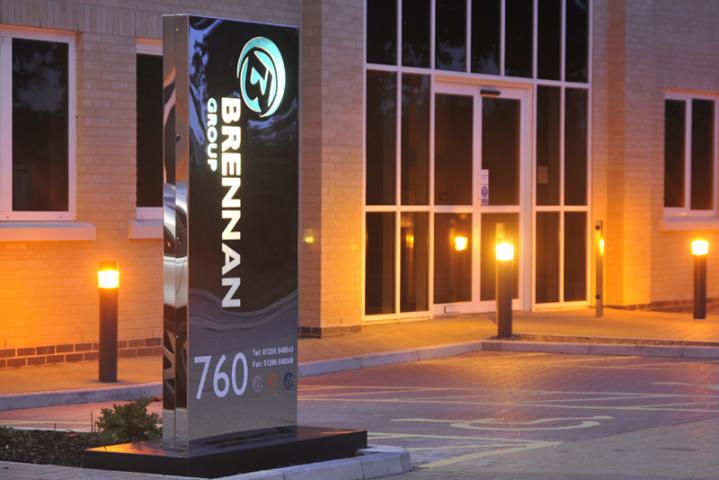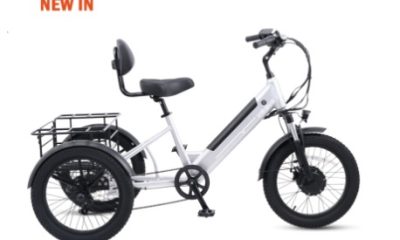Business
Covid-19 Highlights The Need For More Domestic Production
Covid-19 has caused all kinds of disruptions in daily living for people across the world, but one of its most challenging aspects has been supply chain management. As a result of government regulations and the need for common-sense health practices like social distancing and quarantining after infection, manufacturing has suffered along with logistics. All of this has led to a global supply chain crisis, particularly when it comes to overseas shipping.
Cargo ships on the western coast of the United States have been backed up in the hundreds, and whether you’re sourcing brushless motors from another country or you’re importing plastic widgets, there’s no doubt that it’s going to be a while before these items even hit America’s shores. Unfortunately, the ripple effect caused by international supply chain disruption goes on to affect virtually every industry as well as consumers.
How Did We Get Here?
Outsourcing of manufacturing has been an ongoing and controversial topic of discussion among the business community of America for decades. The trend really took off in the 1980s as developing countries opened their doors for business and American companies found a new avenue for manufacturing goods at a lower cost. This has worked well for global trade, even if there have been bumps along the way, but the practice of seeking overseas manufacturing ultimately benefited America’s economy and consumers.
As Covid-19 has demonstrated, however, relying so heavily on international manufacturing and imports leaves the country vulnerable when global shipping is disrupted. If domestic alternatives are not in place or have not been firmly established, there’s nowhere else to turn when demand rises and supply is short. This becomes a bigger problem when you take into account the fact that almost everyone is affected in some way by these disruptions.
Dominoes Falling
As an example of how this creates a domino effect, a business that manufactures drills for the construction industry may rely on small brushless motors, large brushless motors and sensored brushless motors for its products. If the drill manufacturer can’t import DC brushless motors quickly, its own products become scarce.
If construction professionals can’t get their hands on the drills they need for construction projects, the construction industry slows down. This can lead to layoffs. If someone is laid off, they may need to seek unemployment benefits to stay afloat while seeking other work. States with high unemployment may have a harder time paying their own bills due to a rise in government benefit payments. This causes states to struggle financially, potentially leading to a need for federal money. Since less taxes are being paid, money is printed, leading to inflation. This causes a reduction in purchasing power and prices to necessarily rise.
Getting Back To Domestic Manufacturing
While domestic production is not a silver bullet, nor is it an easy solution, it is certainly a solution worth pursuing to avoid the potential for future supply chain disruptions. No one can predict things like Covid-19, but having the economic infrastructure in place to quickly tackle such challenges is one of the most effective ways to combat disruptions going forward.
This can be done in several different ways, but it will require the business community as a whole to make changes to the way it approaches manufacturing. Additionally, business will need to work in partnership with government to find solutions related to taxes and regulations that cause some manufacturers to shy away from domestic production.
And, of course, this is only one piece of the equation in solving international supply chain crises. Logistics professionals will also need to leverage the tools at their disposal to find solutions and innovate in the face of evolving dilemmas. With a lot of hard work and a little bit of luck, the hope is that domestic manufacturing can strengthen the country for everyone the next time a global crisis hits.
Business
How to Customize Your Withdrawal Plan with an SWP Calculator


Financial independence is one of the most sought-after forms of autonomy. No matter the stage of your life, it is always better to have adequate personal finances. Although friends and family are always there for your support, your financial prudence could go a long way. Whether you are just starting your investment journey or getting ready to retire, the customisable SWP calculator is your new best friend.
This calculator takes the guesswork out of generating passive income from your nest egg. Tailor a withdrawal plan that aligns with your personal financial goals. Financial independence doesn’t happen by accident. But equipped with the SWP calculator, you can optimise withdrawals from investments to supplement your income.
In this article, we will explain how the SWP calculator functions.
What is a Systematic Withdrawl Plan (SWP)?
A systematic withdrawal plan (SWP) is a financial manoeuvre that allows you to withdraw money from your investment plan according to your requirements. Depending on the corpus left in your investment fund, you could use a SWP as a source of regular income.
Investors can select the frequency of withdrawals on a monthly, quarterly, or annual basis. You could also choose the date of withdrawal that matches your budget requirements.
Let us understand the underlying benefit of SWP with an example. Consider, for instance, that you have 10,000 units in a mutual fund scheme in India. Depending on your requirements, you set a mandate to withdraw Rs. 4000 through the systematic withdrawal plan on the tenth day of every month.
Starting with January 10, when the fund’s Net Asset Value was Rs. 10 per unit, you would get 400 units. Next month, when the Net Asset Value touches Rs. 15, you will get 266.67 units. You can keep more units in your fund for the same withdrawal amount.
Please note that the above example would hold only when your particular fund is experiencing a growth trend, that is when the fund’s net asset value per unit increases monthly.
What is the SWP Calculator?
An SWP calculator is an automated investment calculator that estimates the possibilities of monthly withdrawals from your investment fund. It shows the total units and the amount remaining in the fund after every withdrawal. Investors in India prefer SWPS for regular monthly income in their retirement years.
Based on the concept of the time value of money, a swap calculator displays the future value of your mutual fund investment. You simply have to enter details such as your investment amount, preferred withdrawal per month, preferred tenure, and expected rate of return. Now, let us move on to understanding the usage of a SWP calculator in detail.
You can rely on the results of a SWP calculator because the final corpus amount is derived with the help of an authentic mathematical formula. A SWP calculator makes use of the following formula:
A = WMT ((1+r/n)^nt-1)/(r/n))
where,
- ‘A’ is the final value of your investment.
- ‘WMT’ is the withdrawal amount.
- ‘n’ is the number of periods over which the compounding will happen (12 for monthly, 3 for quarterly, and 1 for annual).
- ‘t’ is the tenure of your investment in years.
Your SWP calculator will show the final corpus based on the calculations done using this formula.
How to Use a SWP Calculator?
It is easy to understand how a swp calculator works. Here are the step to use the SWP calculator:.
Step 1:
Fill in your total investment amount held in the mutual fund.
Step 2:
Enter the monthly withdrawal limit (Please note that you can even opt for quarterly or annual withdrawals).
Step 3:
Fill in your expected rate of return.
Step 4:
Enter your preferred tenure in terms of years.
You can easily customise the entries of the SWP calculator to analyse the different scenarios that could arise with changes in these entries. Based on your entries made following the steps mentioned above, a SWP calculator will show the results displaying the total investment amount, total interest earned, and the final value of your investment. These results will serve as your aid in finalising your withdrawal limit.
Benefits of a Systematic Withdrawal Plan
There can be less doubt that a systematic withdrawal plan benefits your financial health. Let us understand the main benefits in detail.
1. Source of Regular Income
One of the most essential advantages of a SWP is that it can help you earn a regular income. You can withdraw the money monthly, quarterly, or annually depending on your requirements. All investors interested in earning a regular income can opt for a systematic withdrawal plan.
2. Retirement Income
SWPs offer a stable source of income in your after years. You can use this income to live a stress-free post-retirement life.
3. Availing Tax Benefits
Long-term capital gains to the tune of Rs. 1 lakh are exempt from payment of taxes. You are required to pay taxes only when your accrued gains exceed this threshold.
Benefits of a SWP Calculator
1. Seamless Calculation Process
A SWP calculator lets you accurately assess your final corpus simply by entering details such as the investment amount, expected rate of interest, and withdrawal amount.
2. Finding the Best Withdrawal Plan Calculator
A SWP calculator lets you calculate your corpus amount for different values. You can compare the corpus amounts per your preference and then select the corpus that would meet your requirements in future.
3. Ease of Use
Using an SWP calculator is quite simple. You get the results after entering basic details, such as your required corpus amount.
Conclusion
Who can deny that modern life is entirely uncertain? People need help maintaining their financial wellness. However, with modern instruments such as systematic withdrawal plans, it is easy to manage your financial wellness according to your own preferences.
All you have to do is use a SWP calculator and get an estimate of your corpus. Now that you know all the details of SWP, nothing should stop you from targeting a handsome corpus. For those looking to plan their investments from the start, combining the use of a SIP calculator and SWP calculator can provide a comprehensive view of your financial journey.
Business
The EU Digital Identity Wallet: A Comprehensive Overview


The European Union is spearheading a transformative initiative with the introduction of the EU Digital Identity Wallet. This ambitious project aims to provide EU citizens and residents with a universal digital identity system, enhancing convenience, security, and efficiency in accessing both public and private services. In this article, we explore the key aspects of the EU Digital Identity Wallet, its benefits, challenges, and implications for the future of digital identity in Europe.
1. What is the EU Digital Identity Wallet?
The EU Digital Identity Wallet is a secure and interoperable digital identity system designed to facilitate seamless authentication and verification processes across the European Union. It allows individuals to store and share personal information and credentials digitally, including identity documents, licenses, certificates, and more. The wallet can be accessed through a mobile application, providing a user-friendly interface for managing and presenting digital identity information.
2. Objectives of the EU Digital Identity Wallet
The primary goals of the EU Digital Identity Wallet are:
- Empowering Citizens: To provide individuals with control over their personal data and digital identity.
- Simplifying Access: To streamline access to online services by providing a single, trusted source of identity verification.
- Enhancing Security: To offer a secure and reliable method for digital authentication and reduce fraud and identity theft.
- Promoting Interoperability: To ensure compatibility across EU member states, fostering cross-border digital interactions.
3. Key Features of the Digital Identity Wallet
- Interoperability: Designed to work seamlessly across all EU member states, enabling citizens to use their digital identity in different countries without barriers.
- Data Privacy: Users retain full control over their personal data, deciding what information to share and with whom.
- Multi-Functionality: Beyond simple identification, the wallet supports a range of functionalities, including age verification, electronic signatures, and secure document storage.
- High Security: Incorporates advanced security measures, including encryption and biometric authentication, to protect user data.
4. How the Digital Identity Wallet Works
Registration and Verification: To use the wallet, individuals must first register and verify their identity through a secure process, often involving biometric data and official documentation.
Data Storage: Once verified, users can store various credentials in their digital wallet. These can include identity cards, driver’s licenses, academic diplomas, and other official documents.
Usage: When accessing a service requiring identity verification, users can present their digital wallet. The wallet generates a secure, verifiable digital credential that can be shared with service providers.
Updates and Management: Users can update their stored credentials as needed, ensuring that their information remains current and accurate.
5. Potential Benefits
For Citizens:
- Convenience: Eliminates the need for multiple physical documents and simplifies the process of proving identity online.
- Control: Empowers individuals to manage their own data, enhancing transparency and trust.
For Businesses:
- Efficiency: Reduces the burden of identity verification processes, lowering operational costs.
- Trust: Provides a trusted method for verifying customer identities, enhancing security and compliance.
For Governments:
- Streamlined Services: Facilitates more efficient delivery of public services and reduces administrative overhead.
- Cross-Border Integration: Supports the EU’s vision of a digital single market by enabling cross-border interactions and services.
6. Implementation Challenges
Despite its promising features, the EU Digital Identity Wallet faces several challenges:
- Data Privacy Concerns: Ensuring that user data is adequately protected and that privacy rights are upheld is a critical issue.
- Interoperability: Achieving seamless interoperability across diverse national systems and regulations requires significant coordination and technical standardization.
- Public Adoption: Encouraging widespread adoption among citizens and businesses necessitates addressing concerns about security, usability, and trust.
7. Timeline and Rollout
The EU Digital Identity Wallet is part of the broader European Digital Identity framework. The initiative is progressing through several phases:
- Development: Pilot projects and technological development are underway to refine the system and address potential issues.
- Testing: Extensive testing is being conducted to ensure reliability, security, and user-friendliness.
- Deployment: The wallet is expected to be available for widespread use by 2025, with ongoing updates and improvements based on user feedback and technological advancements.
8. Legal and Regulatory Framework
The EU Digital Identity Wallet operates within a robust legal and regulatory framework designed to ensure security and compliance:
- eIDAS Regulation: The Electronic Identification, Authentication and Trust Services (eIDAS) regulation provides the legal basis for electronic identification and trust services in the EU.
- GDPR Compliance: The General Data Protection Regulation (GDPR) ensures that user data is handled in accordance with strict privacy and data protection standards.
- National Legislation: Each member state must align its national legislation with EU regulations to support the implementation of the digital identity wallet.
9. Future Implications
The EU Digital Identity Wallet has the potential to revolutionize the way individuals interact with both public and private sectors across Europe:
- Digital Transformation: Accelerates the digital transformation of public services and private sector operations.
- Innovation: Creates opportunities for new digital services and applications that leverage secure and verifiable digital identities.
- Economic Growth: Facilitates smoother cross-border trade and interactions, contributing to economic growth and the realization of the digital single market.
10. Conclusion
The EU Digital Identity Wallet represents a significant step towards a more integrated and efficient digital Europe. By providing a secure, user-friendly, and interoperable digital identity solution, it aims to enhance the lives of EU citizens, streamline business operations, and support the digital transformation of public services. As the project moves forward, addressing the challenges of privacy, interoperability, and public adoption will be crucial to its success. The EU Digital Identity Wallet holds the promise of a future where digital interactions are more secure, convenient, and accessible for all.
Business
Popularity of Monolith Signage for Businesses


When it comes to stylish and functional on-street advertising, monolith signs are quickly becoming the clear winner.
Why do so many businesses, from restaurants to fitness centers, choose monolith signs to make their brand stand out and improve the look of their building?
We try to explain.
Distinctive Design and Practical Benefits
One way to get your name and contact information out there is with a monolith sign, which is basically just a freestanding structure.
The design is vertical and striking. It’s a powerful visual for people passing by to increase brand awareness and draw in some customers.
Visibility from a Distance
Visibility is a defining characteristic of monolith signs. They are made to be used on both sides, so the branding is identical on both sides.
This makes them especially useful in areas with a lot of foot traffic, where being seen from all sides is important for getting your message across.
Aesthetic Appeal
People love the clean, powerful look of monolith signs. As long as they fit in with the neighborhood’s visual standards, they look good and show that a business cares about quality and design.
These signs can be lit up, which makes them bright and noticeable, which is important for getting potential customers’ attention from far away.
Flexible Placement
In contrast to traditional signs that may only fit in certain areas of a building’s front, monolith signs can be put anywhere on your property.
For businesses that are not right next to footpaths or high-traffic routes, this is extremely valuable because these signs can be placed in a way that draws attention from busy roads and paths.
Durability and Security
Since they are made of strong materials, monolith signs are sturdy enough to resist vandalism and normal wear and tear.
This makes them a good choice for any business setting. The fact that they are strong means that they will always be a part of your business and help your marketing.
Customization and Professional Installation
If you choose a monolith sign, you are choosing a custom way to advertise. Ice Signs work closely with you from the first design stage all the way through the installation.
We start with a couple of primary designs and finishes and then add your company’s colors, fonts, logos, and pictures to make a sign that is truly unique and represents your business.
Comprehensive Service
Our team is dedicated to giving you a complete experience and making sure that every monolith sign meets your business’s exact needs.
Our experts will hook you up with the right style of placement and installation of the sign, handling all aspects carefully. We stick to health and safety standards for a smooth setup.
Why Invest in Monolith Signage?
The way businesses think about and use outdoor advertising has changed a lot since monolith signage came out. Because it is highly visible, has an eye-catching design, and is built to last, it is a great tool for businesses that want to make a strong impression in a crowded market.
Companies that are thinking about this dynamic advertising option can get a free site survey to figure out what their needs are and how to best meet them.
Talk to our experts about how monolith signs can change the way people see your business and bring in more customers.
Parting Thoughts
You can use monolith signs for reasons other than advertising. They are also a good investment for your business because they will last, be flexible, and fit with your brand.
These signs can be traditional or illuminated. Either way, they make your business stand out in a packed market.
Ice Signs is a company in Leeds that makes custom, hand-made signs, such as metal and illuminated signs. With over 20 years of experience, they deliver tailored design, supply, and installation services for both indoor and outdoor business signage needs.
For more information, visit:
https://www.icesigns.co.uk/products/monolith-signs/
https://www.icesigns.co.uk/products/totem-signs/
-



 Biography6 years ago
Biography6 years agoJacqulyn Elizabeth Hanley is the Mother of Liza Soberano?
-



 Home5 years ago
Home5 years agoEpson L3110 Driver Free Download Latest Updated Version
-



 Games3 years ago
Games3 years agoBest Free To Play MMORPG To Try This 2021
-



 Biography5 years ago
Biography5 years agoAmanda Levy Mckeehan Biography, Family, Net Worth, Age, Affairs, Facts
-



 Biography5 years ago
Biography5 years agoWho is Rose Dorothy Dauriac? Scarlett Johansson Daughter?
-



 Biography5 years ago
Biography5 years agoJessica Ditzel Secret Information that Nobody Knows | Joe Rogan’s Wife
-



 Biography6 years ago
Biography6 years agoWhat is the relation of Nathaniel Larry Osorno with Liza Soberano?
-



 Anime5 years ago
Anime5 years agoOne Piece Filler | The Complete Guide and Updated List 2020































